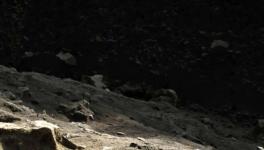Did Archaic Human Species Denisovans Inhabit Tibetan Plateau?
Image Courtesy: The Guardian
So far, anything that is known about the Denisovans, the mysterious archaic human species, was confined to the Denisova caves in Altai Mountain in Siberia. It is so, because the remnants of this ancient species could be discovered in the fossils of the Denisova cave only. But a recent report published in Nature about the discovery of a Denisovan jawbone in a cave in the Tibetan Plateau has opened up many interesting facts about archaic humans.
The fossil has been found to be 1,60,000 years old with a powerful jaw and unusually large teeth, resembling the most primitive Neanderthals. Protein analysis of the fossil revealed that it was closer to the Siberian Denisovans.
The discovery also shows that archaic humans could adapt to an environment of hypoxic, high altitude and extremely low temperatures. The presence of Denisovan genes among the Sherpas and some other Himalayan ethnic communities today, as the scientists say, could be traced to interbreeding between the Denisovans and modern humans.
Interbreeding among the ancient human species like Denisovans, Neanderthals and modern humans have been reported in many researches. One recent research was about a two centimeter bone excavated from Denisova, which belonged to the offspring of two different species— the mother of which was a Neanderthal and the father was a Denisovan.
The dating of the fossil suggests that the temperature in that area during those times would have dipped to -30C. It was much harsher than today. Jean-Jacques Hublin, director, department of human evolution, Max Planck Institute of Evolutionary Anthropology, Germany, and a lead author of the Nature paper said: “This element is spectacular. Until today, nobody imagined that archaic humans could dwell in such an environment.”
The jaw bone fossil was found by a monk in the Baishiya Karst cave on the Tibetal Plateau in the Gansu province belonging to China. The fossil eventually reached the hands of the scientists behind the latest analysis.
The scientists couldn’t extract any DNA from the ancient sample, but what they could manage was to get proteins from one of the molars. They used the technique called the ‘U Series Dating’ or ‘Uranium Thorium Dating’ to find out the age of the proteins, which led them to conclude that the fossil was 1,60,000 years old. Findings till date show that modern humans arrived in the Tibetan Plateau some 40,000 years ago — much more recently than the Denisovans.
Like a DNA sample, proteins could also be sequenced to search for its ancestry. The team had to undertake the painful task of carefully sequencing the trace of the extracted proteins which led to them to conclude that the fossil was that of the Denisovans. Moreover, the EPAS1 (endothelial PAS domain containing protein 1) gene present among the Sherpas and other neighbouring Himalayan natives is a result of introgression of Denisovans into present day populations.
The EPSA1 gene instructs the cell machinery to produce a protein called hypoxia-inducible factor 2-alpha responsible for human body’s adaptation to high-altitude regions where oxygen pressure becomes very low and less oxygen enters into the lungs.
This fossil represents the earliest hominin on the Tibetan Plateau. According to Fahu Chen, the first author of the study: “It is at least 1, 20,000 years older than the oldest known Paleolithic sites in the region”.
Get the latest reports & analysis with people's perspective on Protests, movements & deep analytical videos, discussions of the current affairs in your Telegram app. Subscribe to NewsClick's Telegram channel & get Real-Time updates on stories, as they get published on our website.
























